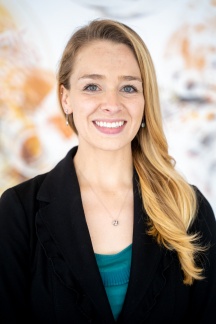
Brittany Hartwell, PhD
Titles
Education
PhD in Bioengineering - Biomolecular Engineering, University of Kansas
BS in Chemical and Biological Engineering, Iowa State University
Fellowships
Biography
Dr. Hartwell began her Biomedical Engineering (BME) faculty appointment in Fall 2021.
The Hartwell Immunoengineering Lab combines perspectives from biomolecular engineering, drug delivery, and immunology to develop antigen-specific immunotherapies and vaccines for applications in autoimmunity, cancer, and infectious disease. Our research focuses on the design and development of molecules that achieve targeted and controlled modulation of the immune system in an antigen-specific manner, directing the immune response towards tolerance (for therapeutic applications in autoimmunity) or immunogenicity (for therapeutic or vaccine applications in cancer and infectious disease). Our rational molecular design approach is motivated by knowledge of inherent transport and cellular mechanisms, with a particular focus on targeting the mucosal immune system. Tuning the physicochemical properties of our molecular platforms allows us to direct 1) antigen delivery, 2) cellular interactions, and 3) the resulting immune response.
The development of molecules capable of targeting the immune system in a specific manner will address a pressing need for safer and more effective disease interventions across multiple disease settings, ranging from autoimmune diseases like MS to infectious diseases like COVID-19. For example, many current therapy options for autoimmunity and cancer act in a nonspecific manner, which translates to reduced efficacy and heightened risk of adverse side effects for patients. Additional value of this work lies in using the molecules we design as investigative tools to provide mechanistic insight, both to further our understanding of the immune response and to guide future design of immunotherapies and vaccines.
Academic Interests and Focus
- Immunoengineering
- Drug delivery
- Biomolecular engineering
Teaching Areas
- Undergraduate BME course in biomedical thermodynamics and kinetics
- Graduate course in immunoengineering
Courses
- BMEn 2101
- BMEn 5910
Publications
See a complete list of publications here:
Hartwell BL, Melo MB, Xiao P, Lemnios AA, Li N, Chang JYH, Yu J, Gebre MS, Chang A, Maiorino L, Carter C, Moyer TJ, Dalvie NC, Rodriguez-Aponte SA, Rodrigues KA, Silva M, Suh H, Adams J, Fontenot J, Love JC, Barouch DH, Villinger F, Ruprecht RM, Irvine DJ. “Intranasal vaccination with lipid-conjugated immunogens promotes antigen transmucosal uptake to drive mucosal and systemic immunity.” Science Translational Medicine. 2022. DOI: 10.1126/scitranslmed.abn1413
Hartwell BL*, Martin JT*, Kumarapperuma S*, Melo MB, Carnathan DG, Cossette BJ, Adams J, Gong S, Zhang W, Tokatlian T, Menis S, Schiffner T, Franklin CG, Goins B, Fox PT, Silvestri G, Schief WR, Ruprecht RM, Irvine DJ. “Combined PET and whole-tissue imaging of lymphatic-targeting vaccines in non-human primates.” Biomaterials. 2021; 275:120868. DOI: 10.1016/j.biomaterials.2021.120868
Silva M, Kato Y, Melo MB, Phung I, Freeman BL, Li Z, Roh K, Van Wijnbergen J, Watkins H, Enemuo CA,Hartwell BL, Chang JYH, Xiao S, Rodrigues KA, Cirelli KM, Li N, Haupt S, Aung A, Cossette B, Kataria S, Bastidas R, Bhiman J, Linde C, Groschel B, Georgeson E, Phelps N, Thomas A, Bals J, Carnathan DG, Lingwood D, Burton DR, Alter G, Padera TP, Belcher AM, Schief WR, Silvestri G, Ruprecht RM, Crotty S, and Irvine DJ. “A potent saponin and TLR agonist particulate vaccine adjuvant alters lymphatic flow and modulates B and T cell responses.” Science Immunology. 2021 Dec 3;6(66). DOI: 10.1126/sciimmunol.abf1152
Dalvie NC, Rodriguez-Aponte SA, Hartwell BL, Tostanoski LH, Biedermann AM, Crowell LE, Kaur K, Kumru O, Carter L, Yu J, Chang A, McMahan K, Courant T, Lebas C, Lemnios AA, Rodrigues KA, Silva M, Johnston RS, Naranjo CA, Tracey MK, Brady JR, Whittaker CA, Yun D, Kar S, Porto M, Lok M, Andersen H, Lewis MG, Love KR, Camp DL, Silverman JM, Kleanthous H, Joshi SB, Volkin DB, Dubois PM, Collin N, King NP, Barouch DH, Irvine DJ, Love JC. “Engineered SARS-CoV-2 receptor binding domain improves manufacturability in yeast and immunogenicity in mice.” Proc National Acad Sci. 2021; 118, e2106845118. DOI: 10.1073/pnas.2106845118
Hartwell BL, Pickens CJ, Leon M, Northrup L, Christopher MA, Griffin JD, Martinez-Becerra F, Berkland C. “Soluble antigen arrays disarm antigen-specific B cells to promote lasting immune tolerance in experimental autoimmune encephalomyelitis.” Journal of Autoimmunity. 2018; 93(9):76-88. DOI: 10.1016/j.jaut.2018.06.006
Hartwell BL, Pickens CJ, Leon M, Berkland C. “Multivalent antigen arrays exhibit high avidity binding and modulation of B cell receptor-mediated signaling to drive efficacy against experimental autoimmune encephalomyelitis.” Biomacromolecules. 2017; 18(6):1893-1907. DOI: 10.1021/acs.biomac.7b00335
Hartwell BL, Martinez-Becerra F, Chen J, Shinogle H, Sarnowski M, Moore D, Berkland C. “Antigen-specific binding of multivalent soluble antigen arrays induces receptor clustering and impedes B cell receptor mediated signaling.” Biomacromolecules. 2016; 17(3): 710-22. DOI: 10.1021/acs.biomac.5b01097
Hartwell BL, Smalter Hall A, Swafford D, Sullivan BP, Garza A, Sestak JO, Northrup L, Berkland C. “Molecular dynamics of multivalent soluble antigen arrays support two-signal codelivery mechanism in treatment of experimental autoimmune encephalomyelitis.” Molecular Pharmaceutics. 2016; 13(2): 330-43. DOI: 10.1021/acs.molpharmaceut.5b00825
Hartwell BL, Antunez L, Sullivan BP, Thati S, Sestak JO, Berkland C. “Multivalent nanomaterials: learning from vaccines and progressing to antigen-specific immunotherapies.” Journal of Pharmaceutical Science. 2015; 104(2): 346-61. Epub 2014. DOI: 10.1002/jps.24273